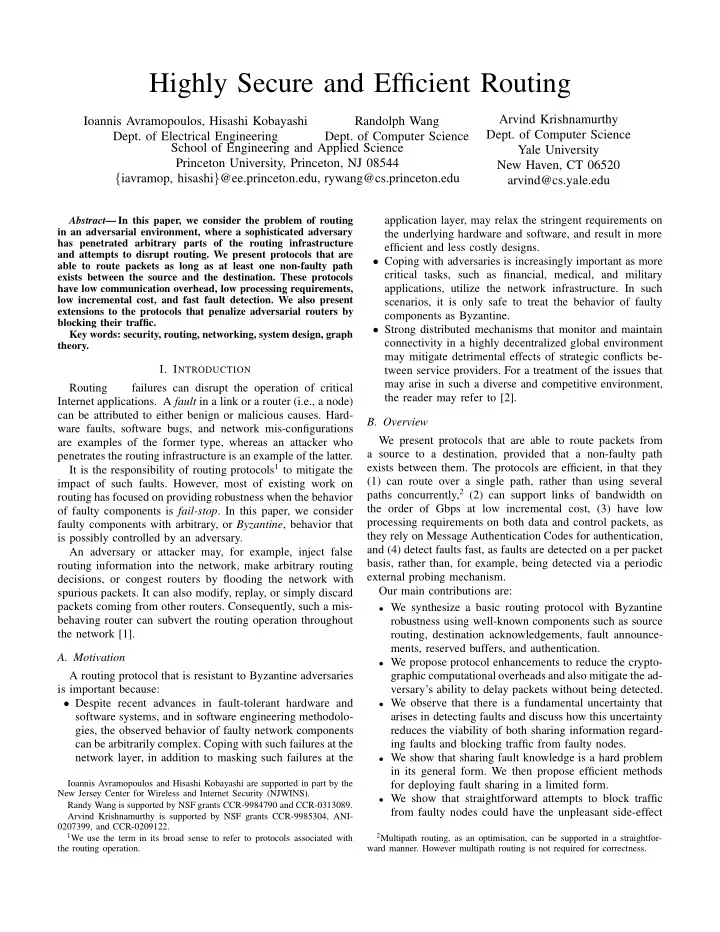

Highly Secure and Efficient Routing Arvind Krishnamurthy Ioannis Avramopoulos, Hisashi Kobayashi Randolph Wang Dept. of Computer Science Dept. of Electrical Engineering Dept. of Computer Science School of Engineering and Applied Science Yale University Princeton University, Princeton, NJ 08544 New Haven, CT 06520 { iavramop, hisashi } @ee.princeton.edu, rywang@cs.princeton.edu arvind@cs.yale.edu Abstract — In this paper, we consider the problem of routing application layer, may relax the stringent requirements on in an adversarial environment, where a sophisticated adversary the underlying hardware and software, and result in more has penetrated arbitrary parts of the routing infrastructure efficient and less costly designs. and attempts to disrupt routing. We present protocols that are • Coping with adversaries is increasingly important as more able to route packets as long as at least one non-faulty path critical tasks, such as financial, medical, and military exists between the source and the destination. These protocols applications, utilize the network infrastructure. In such have low communication overhead, low processing requirements, low incremental cost, and fast fault detection. We also present scenarios, it is only safe to treat the behavior of faulty extensions to the protocols that penalize adversarial routers by components as Byzantine. blocking their traffic. • Strong distributed mechanisms that monitor and maintain Key words: security, routing, networking, system design, graph connectivity in a highly decentralized global environment theory. may mitigate detrimental effects of strategic conflicts be- I. I NTRODUCTION tween service providers. For a treatment of the issues that may arise in such a diverse and competitive environment, Routing failures can disrupt the operation of critical the reader may refer to [2]. Internet applications. A fault in a link or a router (i.e., a node) can be attributed to either benign or malicious causes. Hard- B. Overview ware faults, software bugs, and network mis-configurations We present protocols that are able to route packets from are examples of the former type, whereas an attacker who a source to a destination, provided that a non-faulty path penetrates the routing infrastructure is an example of the latter. It is the responsibility of routing protocols 1 to mitigate the exists between them. The protocols are efficient, in that they (1) can route over a single path, rather than using several impact of such faults. However, most of existing work on paths concurrently, 2 (2) can support links of bandwidth on routing has focused on providing robustness when the behavior the order of Gbps at low incremental cost, (3) have low of faulty components is fail-stop . In this paper, we consider processing requirements on both data and control packets, as faulty components with arbitrary, or Byzantine , behavior that they rely on Message Authentication Codes for authentication, is possibly controlled by an adversary. and (4) detect faults fast, as faults are detected on a per packet An adversary or attacker may, for example, inject false basis, rather than, for example, being detected via a periodic routing information into the network, make arbitrary routing external probing mechanism. decisions, or congest routers by flooding the network with Our main contributions are: spurious packets. It can also modify, replay, or simply discard packets coming from other routers. Consequently, such a mis- • We synthesize a basic routing protocol with Byzantine behaving router can subvert the routing operation throughout robustness using well-known components such as source the network [1]. routing, destination acknowledgements, fault announce- ments, reserved buffers, and authentication. A. Motivation • We propose protocol enhancements to reduce the crypto- A routing protocol that is resistant to Byzantine adversaries graphic computational overheads and also mitigate the ad- is important because: versary’s ability to delay packets without being detected. • Despite recent advances in fault-tolerant hardware and • We observe that there is a fundamental uncertainty that software systems, and in software engineering methodolo- arises in detecting faults and discuss how this uncertainty gies, the observed behavior of faulty network components reduces the viability of both sharing information regard- can be arbitrarily complex. Coping with such failures at the ing faults and blocking traffic from faulty nodes. network layer, in addition to masking such failures at the • We show that sharing fault knowledge is a hard problem in its general form. We then propose efficient methods Ioannis Avramopoulos and Hisashi Kobayashi are supported in part by the for deploying fault sharing in a limited form. New Jersey Center for Wireless and Internet Security (NJWINS). • We show that straightforward attempts to block traffic Randy Wang is supported by NSF grants CCR-9984790 and CCR-0313089. from faulty nodes could have the unpleasant side-effect Arvind Krishnamurthy is supported by NSF grants CCR-9985304, ANI- 0207399, and CCR-0209122. 1 We use the term in its broad sense to refer to protocols associated with 2 Multipath routing, as an optimisation, can be supported in a straightfor- the routing operation. ward manner. However multipath routing is not required for correctness.
Recommend
More recommend